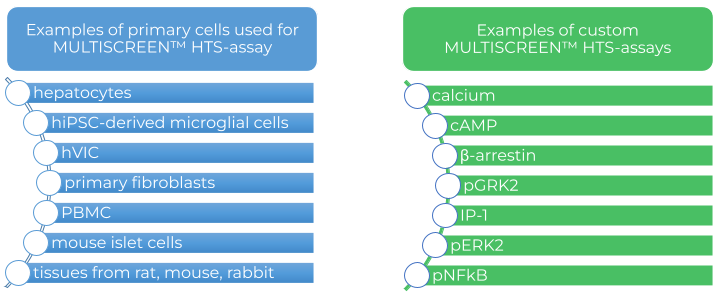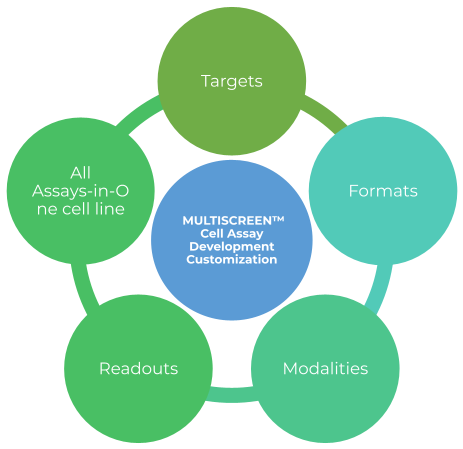Custom Cell Based Assays Development Services
Rapid Cell Based Assay Development for GPCR, Nuclear Hormone Receptors, Kinases, Transporters, and More
What is an Assay in Biology?
In biology, an assay is a method or procedure employed to analyze and measure the presence, concentration, activity, or function of a biological molecule or substance. Assays serve as fundamental tools in biological research and diagnostics, offering a means to quantify and study various biological components, including proteins, enzymes, nucleic acids, or small molecules. These assays play a crucial role in drug development, specifically screening for the effects of drugs or compounds. Depending on the nature of the biological target and the desired outcome, different types of assays are utilized, such as enzyme assays, immunoassays, cell-based assays, and molecular assays. By providing valuable information, assays contribute significantly to our understanding of biological processes and play a pivotal role in the development of applications in areas such as drug discovery, diagnostics, and biotechnology.
Cell Based Assays Development for Assessing Small Molecule and Biologic Effects on Target Proteins
They are integral parts of the entire drug discovery process from target validation, high throughput screening (HTS), lead optimization, preclinical and clinical development to NDA or BLA approval. They are used to measure the activity of a compound on an intended therapeutic target, or toxicity effect on an undesired off-target protein.
Often these are in vitro assays developed for accessibility and lower cost than animal based assays. Two key criteria for an assay are 1) to reflect the biology of the target in vivo and 2) in high throughput. In cell-based assays, the target activity can be measured in physiologically relevant host cells and signaling pathways. Therefore, live cell-based assays are strongly preferred over protein-based biochemical assays. However, it is challenging to develop cell-based assays that are amenable for high throughput screening.
Cell-based assay development service is among Multispan’s highly-valued offerings. A series of decisions need to be made before each development project. What cell line to use? What readout to use? What biological event to measure? What mode of action to measure?

Want to learn more about the assay development and screening process?
Unlock Target Biology: What Cell Line to Use?
At Multispan, we combine cell engineering, assay development, and HTS experience to succeed. Our commitment to excellence is reflected in our thoughtfully developed, battled-tested MULTISCREENTM process, which begins with choosing the right cell line.
There are two main types of assays that are routinely developed by the Multispan team, based on the cell types used: either primary cells expressing endogenous protein target or heterologous recombinant stable cell lines. We have developed various HTS assays in hepatocytes, hiPSC derived microglial cells, human ventricle interstitial cardiomyocytes (hVIC), primary fibroblasts, PBMC, mouse islet cells, etc. In the case of the 2nd category, we employ Multispan’s highly characterized MULTISCREENTM stable cell lines, designed, generated, and QC’ed for high throughput screening assays. These assays are primarily cell signaling focused.

Navigate Assay Methods: Choose the Right Assay Readout
The next important decision relies on the selection the most appropriate readouts for specific research needs. Our expertise spans a range of assay types, including ELISA, cell-based ELISA, reporter assays, binding assays, 2nd messenger assays, flow cytometry (FACS) in fluorescence, chemiluminescence assays, TR-FRET assays, absorbance assays, and even radioisotope-based assays.
We understand that the choice of readout is crucial in accurately measuring the biological events and mode of action in your research. This precision allows us to offer customized solutions to meet the unique requirements of each program we support and to contribute to its success.
Strategize Cell Assay Development: Choose the Biology to Measure
We have successfully applied these technologies in developing assays for serine/threonine kinases, receptor tyrosine kinases, nuclear hormone receptors, transporters, ion channels, etc. For G-protein coupled receptor (GPCR) targets, the specific assays include: Calcium, cAMP, β-arrestin, pGRK2, IP-1, pERK, pNFκB, radioligand binding, GTPγS, chemotaxis, cytokine secretion, insulin secretion, cell proliferation, luciferase reporter and internalization.
Notably, the latest MULTISCREENTM β-Arrestin Sensor makes it possible for the first time to assay orphan GPCRs (oGPCRs) in their native form in HTS. It also makes it possible to assay signaling biased ligands using untaggaed GPCRs in heterologous or primary cells in HTS for the first time.
In addition to human targets, assays with comparable pharmacology for mouse, rat, ferret, rabbit, dog, pig, and non-human primate ortholog targets have also been developed. To complement cell-based assays, radioligand binding assay and GTPγS assays are often performed using primary tissue homogenates such as human or rat, mouse and rabbit brain tissues from wildtype or transgenic animals.
Tailor Assay for HTS: Choose Mode of Action
At Multispan, our approach to developing cellular assays is intricately tied to the biology of each target and the specific mechanism of therapeutic intervention. We recognize that a one-size-fits-all approach simply won’t suffice. Thus, we incorporate the different modalities in our MULTISCREENTM development process as High-Throughput Screening (HTS) is intended, ensuring that assays are meticulously tailored to meet the screening requirements.
These modalities encompass a spectrum of modes, including agonist, partial agonist, antagonist, partial antagonist, inverse agonist, positive allosteric modulator (PAM), and negative allosteric modulator (NAM) modes. Each mode is selected with precision, aligning with the unique biology of the target and the intended therapeutic outcome.
Our commitment to excellence extends to the careful selection of tool compounds for each assay development. These compounds are chosen to reflect the specific targeted mode of action, ensuring that MULTISCREENTM assays are not only highly robust but also aligned with the intricate details of the research objectives of each program we support.

Finally, to develop and optimize an assay, extensive optimization steps are often taken to arrive at high signal-to-background ratio, and pharmacologically relevant efficacy and potency, measured by tool compounds. Multispan’s assay experts not only rely on in-depth experience and knowhow accumulated over nearly 2 decades of practice, but also leverage the high quality MULTISCREENTM stable cell lines and assay reagents where possible. The majority of our cell-based assays are developed and validated in 384-well microtiter plate format. The minimum requirement of Z is 0.5 to ensure an assay HTS is compatible. For HTS performed at Multispan, our standard Z’ goal is 0.7.
